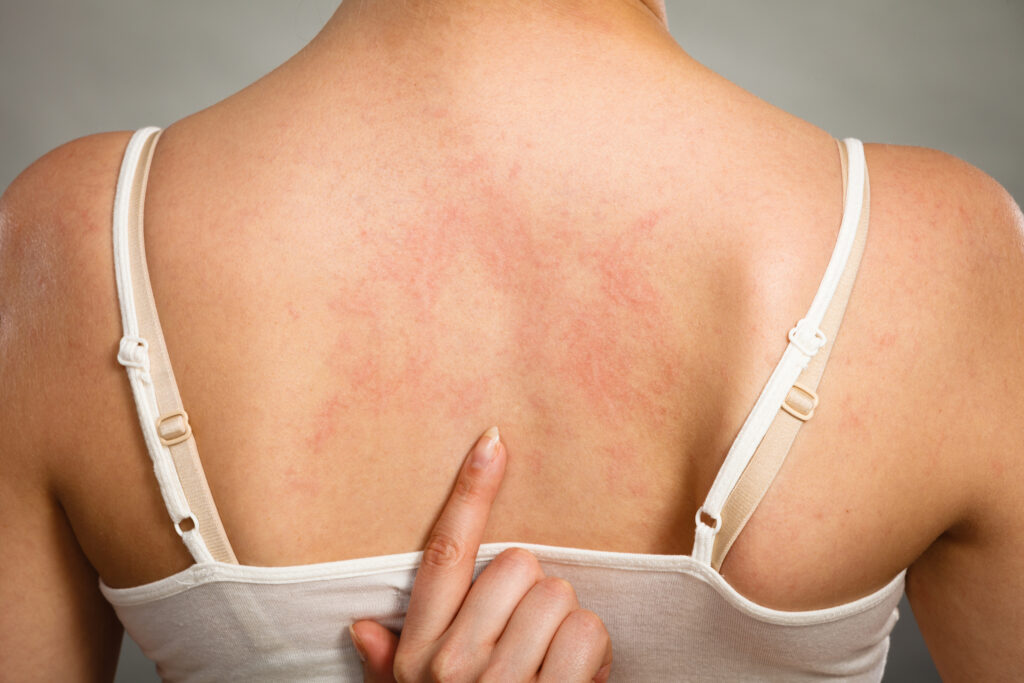Atopic Dermatitis
Atopic dermatitis is the most common type of eczema that affects up to 20% of children and 5-10% of adults.
Causing dry, itchy, and cracked skin, atopic dermatitis is usually a long-term condition that requires ongoing treatment to manage.
The below guide will tell you everything you need to know about atopic dermatitis.
Read on to discover
- What is atopic dermatitis?
- What are the most common atopic dermatitis symptoms?
- What parts of the body does atopic dermatitis affect?
- Who is most at risk of developing atopic dermatitis?
- What are the most common causes of atopic dermatitis?
- How to diagnose atopic dermatitis?
- When to see your GP about atopic dermatitis?
- What is the best treatment for atopic dermatitis?
- How to treat atopic dermatitis at home
- How to prevent outbreaks of atopic dermatitis?
- How to live with atopic dermatitis
- What are other types of eczema?
- Atopic Dermatitis FAQs
What is atopic dermatitis?
Atopic dermatitis, also known as atopic eczema, is a chronic skin disease, often a long-term, which requires ongoing treatment to manage. It mostly affects children, but adults can also suffer from this condition.
Many people experience periods of time where their symptoms flare up, which are followed by periods of remission. Although there isn’t a cure for atopic dermatitis, infantile atopic dermatitis often goes away as the child gets older. In regard to atopic dermatitis in adults, there are several medications and treatments available that can manage the symptoms and reduce the number of outbreaks.
What are the most common atopic dermatitis symptoms?
What are the most common atopic dermatitis symptoms?
Some people experience mild atopic dermatitis symptoms, and others suffer from more severe atopic dermatitis.
Symptoms that occur in most atopic dermatitis cases include:
- Itchy skin
- Very dry skin
- Cracked skin
- Inflamed skin
- Red patches on light skin
- Brown, purple or grey patches on dark skin

What parts of the body does atopic dermatitis affect?
Atopic dermatitis can affect the skin on any area of the body, but the most commonly affected areas are:
- Hands
- Scalp
- Elbows
- Knees
- Face
In addition a atopic dermatitis can also affect eyelid, breast, feet, atopic neck, and legs.
Who is most at risk of developing atopic dermatitis?
Atopic dermatitis most commonly develops in childhood, typically in the first few months of a baby’s life. Even though it is the most common type of eczema, atopic dermatitis is often long-lasting and severe.
In some children, atopic dermatitis can go away as they grow up. However, others will have this condition throughout their lives.
People with either asthma or allergies such as hay fever are also more likely to develop atopic dermatitis.
What are the most common causes of atopic dermatitis?
There is no definitive cause of atopic dermatitis, but in addition to genetic susceptibility it is known that there are several contributing factors to this condition.
Some of the most common causes of atopic dermatitis are as follows:
Allergies and asthma
If you have any allergies or suffer from asthma, you are more likely to develop atopic dermatitis. If allergies and asthma run in your family, for example, one or both of your parents have allergies or asthma, you are also more at risk of developing this condition.
Harsh detergents and soaps
A common trigger is the use of harsh soaps or detergents. These can irritate sensitive skin and cause an atopic dermatitis flare-up. These can also make the symptoms of atopic dermatitis worse.
If you work in an environment where your hands are often wet, you are more likely to develop dermatitis on your hands and dermatitis on your fingers.
Environment
Cold, dry weather can cause atopic dermatitis flare-ups. Again, this can also make symptoms such as itchiness, dryness, and chapped skin worse.
Stress
Stress can wreak havoc with your immune system and cause atopic dermatitis outbreaks. To avoid this, practice stress-banishing techniques such as meditation, breathing, and yoga.
Food allergies
Certain foods are known for triggering atopic dermatitis, so they should be avoided if you suffer from this condition. These include dairy products, eggs, wheat, and soy products.
Sleep issues
If you get caught in an itch-scratch cycle, this can make your symptoms worse and make outbreaks more frequent. It can also disrupt your sleep patterns, resulting in your skin taking longer to heal.
How to diagnose atopic dermatitis?
If you think you may have atopic dermatitis but you have not yet been officially diagnosed with this condition, it is a good idea to book an appointment with your doctor or dermatologist.
Typically, a doctor or dermatologist can diagnose atopic dermatitis on the spot without the need for any testing.
During your appointment, you are likely to be asked some or all of the following questions:
- When did your symptoms first appear?
- Is your rash itchy?
- Does your rash come and go?
- Is there a history of atopic dermatitis or eczema in your family?
- Do you have any allergies or asthma?
- What is your diet/lifestyle like? Such as, do you smoke?
When to see your doctor about atopic dermatitis?
In many cases, atopic dermatitis can be treated with over-the-counter treatments and lifestyle changes. Book an appointment with your if you experience any of the below:
- Difficulty in sleeping or carrying out daily activities due to your symptoms
- Signs of a skin infection such as pus, yellow scabs, or red streaks on the skin
Worsening symptoms despite home remedies and OTC treatments
What is the best treatments and skin care products for atopic dermatitis?
The best atopic dermatitis treatment is dependent on how severe your symptoms are and which parts of your body are affected.
Atopic dermatitis doesn’t have a cure, but several treatments have been proven to soothe the skin and reduce the frequency of outbreaks.
Emollients
Emollients are moisturising creams to be applied directly to the skin to soothe soften and hydrate it.
Emollients such as Locobase Repair and Everyday Special Body Lotion are skin care products (cosmetic products), intended to soften the skin and restore the natural skin barrier. Locobase Everyday Special Body Lotion is suitable for dry and sensitive skin, while Locobase Repair is for very dry and cracked skin. These emollients are perfect choice for daily skincare of the atopic skin. Locobase Eczema Cream is a topical medical device with excellent moisturizing properties. It is clinically proven to effectively treat the symptoms of mild and moderate atopic dermatitis such as itching and redness.
You can buy emollient creams over-the-counter without the need for a prescription from your doctor or dermatologist.
Topical corticosteroids
Topical corticosteroids are a type of anti-inflammatory medication used to treat a wide range of conditions, including atopic dermatitis.
These creams can be used to reduce swelling, redness, and itching during atopic dermatitis flare-ups.
Exfoliants
Exfoliation is the process of removing dead skin cells from the surface of the skin. It improves the appearance of the skin overall and makes room for new, healthy skin cells to grow in.
Although you should never exfoliate weeping or oozing eczema, you can use exfoliants on thick and dry areas of skin. For example, if you have thick, dry or flaky skin on your feet, Footner Exfoliation Socks can effectively remove dead skin cells and help to improve the appearance of the skin on your feet.
When using an exfoliant for atopic dermatitis, make sure that you rub the affected area gently in short circular motions and then rinse with warm water.

Lifestyle changes How to treat atopic dermatitis at home
There are also several lifestyle changes that you can make in combination with topical treatments and taking care of your skin with emollients to manage your condition and reduce episodes. These include:
Manage your stress levels
As mentioned earlier, stress is a common trigger of atopic dermatitis, so you need to ensure that you keep your stress levels under control. While some stress is good for the body, too much puts it under pressure.
To lower your stress levels:
- Perform breathing techniques
- Try meditation
- Practice yoga
- Partake in regular exercise
- Take sufficient me-time
Get enough sleep
There is a reason why everything feels worse when you get a bad night’s sleep. It is because this is the time when your body heals and repairs itself. To reduce atopic dermatitis outbreaks and to promote skin healing, make sure that you get the recommended 7-8 hours of sleep each night.
Eat a nutritionally balanced diet
You need to make sure that you give your body all the vitamins and minerals it needs to thrive and keep your skin in optimum condition. It can also be a good idea to limit your intake of trigger foods such as milk and other dairy products, eggs, soy, wheat, fish and shellfish, and peanuts.
How to prevent outbreaks of atopic dermatitis?
There are several best practices that you can adopt to prevent atopic dermatitis flare-ups, including:
- Moisturise your skin twice a day with an emollient cream that is designed to lock in moisture
- Identify and avoid any of your atopic dermatitis triggers
- Take shorter baths and showers and use warm water rather than hot
- Only use gentle soaps, washing powders, and cosmetics
- Dry yourself gently after washing while your skin is still damp
How to live with atopic dermatitis
Living with a long-term skin condition such as atopic dermatitis can be challenging, especially if you suffer from severe atopic dermatitis.
To manage the physical effects of atopic dermatitis, it can be a case of trial and error to see what works best for your skin. You need to be persistent in your efforts and try to remain positive about treatment.
For any mental effects caused by your atopic dermatitis diagnosis, it can be beneficial to speak to your friends and family about how you feel. You can also reach out to the National Eczema Society for people living with eczema.

What are other types of eczema?
Although atopic dermatitis is the most common form of eczema, there are several other types that it can be useful to be aware of. These include:
- Discoid eczema
- Contact dermatitis
- Varicose eczema
- Seborrheic eczema
- Dyshidrotic eczema
Atopic Dermatitis FAQs
What is the primary symptom of atopic dermatitis?
The primary symptom of atopic dermatitis is dry and itchy skin that often displays a red rash during outbreaks.
What triggers atopic dermatitis?
There are many atopic dermatitis triggers, including stress, allergies, environmental factors such as cold weather and irritants such as harsh soaps, detergents, and cosmetics.
What is the fastest way to cure atopic dermatitis?
In most cases, there is no cure for the condition. You can use corticosteroids specially formulated for eczema skin and/or emollients for daily skincare. If your child has eczema, they may simply grow out of this condition with time.
What is the best practice against atopic dermatitis?
Try topical creams such as corticosteroids and emollients, oral medication and lifestyle changes such as lowering your stress levels and taking special baths.
What does atopic dermatitis look like?
Atopic dermatitis appears as a red rash on the skin, often swollen and itchy. In people with dark skin, this rash appears either purple, brown, or grey.
What is the difference between eczema and atopic dermatitis?
Atopic dermatitis is the most common form of eczema, affecting between 10-20% of children and 5-10% of adults.
Links & Sources
- Link item one
- Link item two
- Link item three
No products found